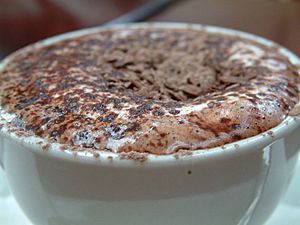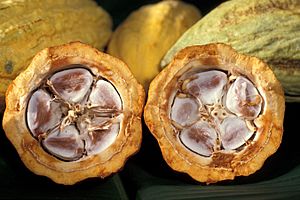Hot chocolate facts for kids
Hot chocolate (also known as hot cocoa or drinking chocolate) is a warm drink. People usually make it by mixing chocolate or cocoa powder and sugar. They add warm milk or water. Many people drink hot chocolate to feel cozy or happy. Some studies even suggest it might be good for you. This is because cocoa has special things called antioxidants. Long ago, until the 1800s, doctors even used hot chocolate as a medicine!
People think the first hot chocolate drink was made by the Mayan people. This was about 2,000 years ago. Later, the Aztecs also made a cocoa drink around 1400 AD/CE. The drink became popular in Europe after it came from Mexico. Since then, it has changed a lot. Today, people drink hot chocolate all over the world. There are many types. For example, cioccolata densa in Italy is very thick. The hot cocoa in the United States is usually thinner.
Contents
History of Hot Chocolate
Chocolate comes from cocoa beans. These are the dried seeds of the cacao tree. The cacao tree is a small tree that grows in warm, tropical areas of the Americas. Scientists believe the most common type of cacao first grew in the Amazon basin. People then moved it to other parts of South and Central America to farm. The scientific name for the cacao tree, Theobroma, means "food of the gods".
The cacao tree grows a fruit called a cacao pod. It looks like an oval, about 15–30 cm (6–12 in.) long. When it is ripe, it turns from yellow to orange.
The first known use of cacao was found in Honduras. People used it there around 1100 BC/BCE. Later, around 460–480 AD/CE, a Mayan grave in Guatemala had cups with Mayan words for cacao. These cups had traces of an old chocolate drink. The Maya are often given credit for making the first chocolate drink over 2,000 years ago. This drink would later change a lot in Europe.
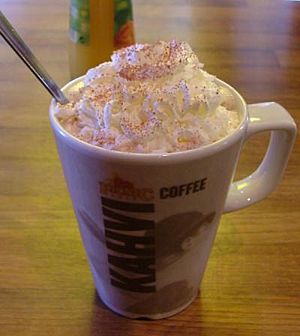
To make their drink, the Maya would grind cocoa seeds into a paste. They mixed it with water, cornmeal, chile peppers, and other spices. Then, they poured the drink back and forth between a cup and a pot. This created a lot of foam. The Maya served this drink cold. Both rich and poor Maya people drank it. But rich people used fancy cups.
By the 1400s, the Aztecs ruled a large part of Mesoamerica. They also started using cacao. They linked chocolate to Xochiquetzal, their goddess of pregnancy. They also used chocolate drinks as offerings to their gods. The Aztec version of the drink was bitter and spicy. They called it xocolatl. It was made much like the Mayan chocolate drinks. They added vanilla, chile pepper, and achiote. People believed it helped fight tiredness. This is because of a substance called theobromine, which can make you feel better. Cacao did not grow in central Mexico. So, it had to be brought into the Aztec empire. This made chocolate a valuable luxury item. Cocoa beans were even used as money.
Europeans first saw chocolate in the 16th century. Montezuma, the Aztec ruler, showed xocolatl to Hernán Cortés. Cortés was a Spanish explorer. The Spanish called it "chocolatl". It was a cold drink made with a chocolate base, vanilla, and other spices. Montezuma's rulers were said to drink about 2,000 cups of xocolatl every day. Montezuma himself drank 50 cups.
At first, Europeans did not like xocolatl. This was because sugar had not yet come to the Americas. The drink tasted spicy and bitter, very different from today's hot chocolate. It is not clear when or by whom xocolatl was first made warm. However, José de Acosta, a Spanish missionary, described xocolatl in the late 16th century. He said it was a bitter drink that the native people loved.
European Changes to Hot Chocolate
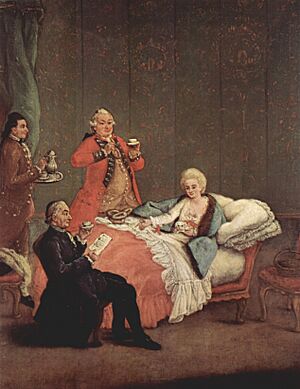
After defeating the Aztecs, Cortés returned to Spain in 1528. He brought cocoa beans and tools for making chocolate drinks. At this time, chocolate was still the bitter drink made by the Mayans. Sweet hot chocolate and bar chocolate did not exist yet.
Once in Europe, the drink slowly became popular. The court of King Charles V soon began drinking it. What was then called "chocolate" became a popular drink among the Spanish upper class. Cocoa was also given as a gift when Spanish royalty married other royal families. Chocolate cost a lot in Europe because cacao beans only grew in South America.
The first shipment of chocolate for sale in Europe arrived in Seville in 1585. It was still a drink. But Europeans added sugar to make it sweet. They also removed the chili pepper. They added vanilla, cinnamon, and other spices instead. This created sweet hot chocolate. It became a luxury item for European royalty in the 17th century. Even when the first Chocolate house (like a coffee shop today) opened in 1657, the drink was still very expensive. A pound cost 50 to 75 pence (which would be like 50 to 75 US dollars today).
In the late 1600s, Hans Sloane, a doctor, visited Jamaica. He tried chocolate there and did not like it much. But he found it tasted better with milk. When he returned to England, he brought this idea with him. This helped bring milk chocolate to Europe.
In 1828, Coenraad Johannes van Houten created the first machine to make cocoa powder in the Netherlands. This machine pressed the greasy cocoa butter out of cacao seeds. What was left was a chocolate powder. This powder, like the cocoa powder we use today, was easier to mix into milk and water. It also led to the creation of solid chocolate. By using cocoa powder and a little cocoa butter, bar chocolate could finally be made. After this, the word "chocolate" often started to mean solid chocolate, not just the drink.
How Hot Chocolate is Used and Its Types
Today, people drink hot chocolate all over the world. But there are two main types. The biggest difference between them is how thick they are.
Names for Hot Chocolate
The words "hot chocolate" and "hot cocoa" are sometimes used to mean the same thing. But there is a small difference. "Hot cocoa" is made from a mix of cocoa, sugar, and other powdered ingredients. These make the drink thick without using cocoa butter. "Hot chocolate" is made directly from bars of chocolate. These bars already contain cocoa, sugar, and cocoa butter. The main difference is the cocoa butter. Hot cocoa has less fat than hot chocolate, so it can be a bit healthier.
You can make hot chocolate with dark, semisweet, or bittersweet chocolate. You cut the chocolate into small pieces and stir it into milk with sugar. Some American hot cocoa powders include powdered milk. This means you can make them just by adding hot water. In the United Kingdom, "hot chocolate" is a sweet chocolate drink made with hot milk or water. It uses a powder with chocolate, sugar, and powdered milk. "Cocoa" usually means a similar drink made with just hot milk and cocoa powder, then sweetened with sugar.
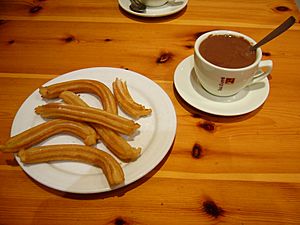
Hot Chocolate in North America
In the United States, hot chocolate is most popular in powdered form. People make it with hot water or milk. This is the thinner of the two main types. It is very sweet. It is often served with marshmallows, whipped cream, or a piece of solid chocolate. European hot chocolate first came to the U.S. in the 1600s with the Dutch. But colonists started selling it around 1755. In the United States, people usually drink hot chocolate in cold weather and winter. It is not often served with meals.
In Mexico, hot chocolate is still very popular. Besides instant powder, Mexican hot chocolate uses semi-sweet chocolate, cinnamon, sugar, and vanilla. This type of hot chocolate is often sold in tablets or bars. You can put these into hot milk, water, or cream. Then you mix it until the drink gets a creamy foam. Mexican cinnamon hot chocolate is often served with Mexican breads or pastries called pan dulce ("sweet bread") and churros.
Hot Chocolate in Europe
In Europe, most types of hot chocolate are very thick. This is because they are made from pure chocolate. In the United Kingdom, hot chocolate is usually thinner. Since Europe was where hot chocolate first became popular, there are many different kinds.
One thick type of hot chocolate in Europe is the Italian cioccolata densa. German types are also known for being very thick and heavy. Hot chocolate and churros are a common breakfast in Spain. This Spanish hot chocolate can be so thick that it is almost like warm chocolate pudding.
There are even more types of thick hot chocolate in Europe. Some cafes in Belgium and other parts of Europe serve a "warme chocolade" or "chocolat chaud". This is a cup of heated milk and a small bowl of bittersweet chocolate chips. You add the chips to the milk yourself. In England, some powdered drinks can be as thick as those made from pure chocolate.
Health Benefits and Drawbacks
Even though people usually drink hot chocolate for fun, it can also have some health benefits. Hot chocolate has many antioxidants that might be good for your health. From the 16th to 19th centuries, hot chocolate was used as both a medicine and a drink. Explorer Francisco Hernández wrote that chocolate drinks helped with fever and liver diseases. Another explorer, Santiago de Valverde Turices, thought that large amounts of hot chocolate were good for chest problems. He also believed small amounts could help stomach problems. When chocolate first came to France in the 17th century, people used it "to fight against fits of anger and bad moods." This might be because chocolate contains chemicals that can improve a person's mood.
However, there are also a few less healthy effects. Hot chocolate can have a lot of calories, saturated fat, and sugar. The caffeine found in the cocoa in hot chocolate might also have some minor negative effects.
Related pages
Images for kids
-
Silver chocolate pot, France, 1779. Victoria and Albert Museum, London
-
Filipino tsokolate with suman rice cakes and ripe carabao mangoes
-
Trembleuse or Gobelet et soucoupe enfoncé by Sèvres c. 1776 designed for drinking hot chocolate
-
A woman (Aline Masson) drinking a cup of chocolate, in a painting by Raimundo Madrazo
See also
 In Spanish: Chocolate caliente para niños
In Spanish: Chocolate caliente para niños


